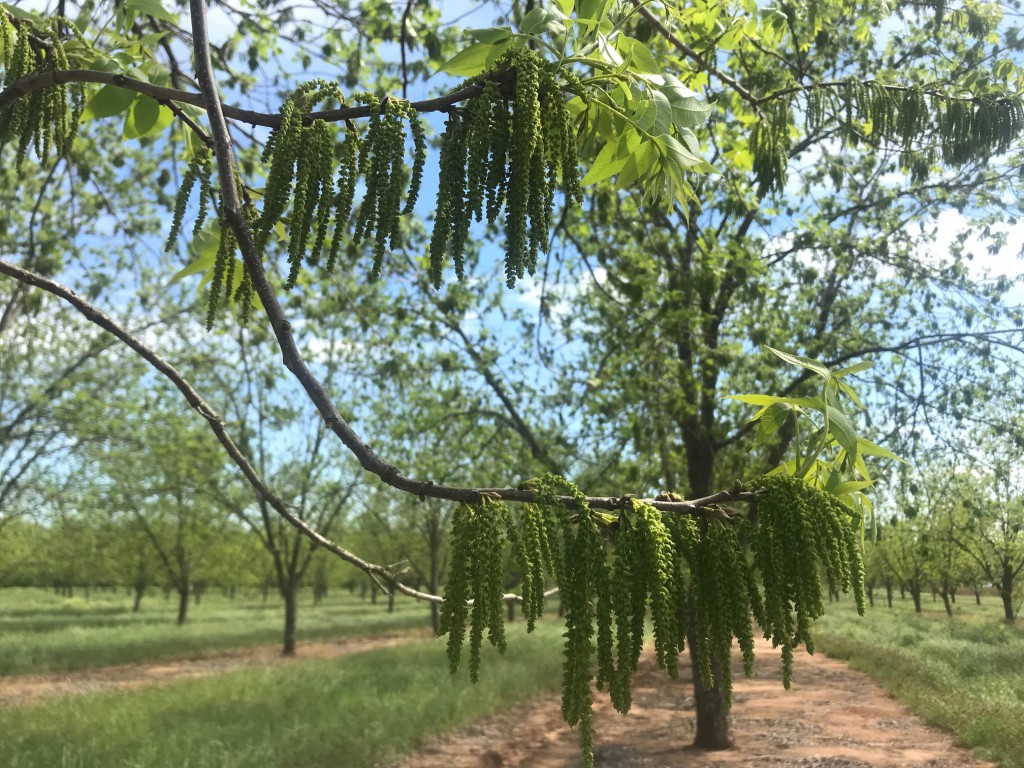It seems pecan trees are lagging behind this year. Well, what is going on exactly and what does this mean? The timing of pecan budbreak and fruit set is determined by a combination of chill hours accumulated in the dormant season and heat units accumulated in spring. If we have a cold winter and accumulate a high amount of chill hours, there are less heat units required to generate budbreak. The warmer it is therafter, the faster the foliage develops and the flowers form. On the other hand, if we have fewer chill hours, it will theoretically take more heat units to stimulate budbreak and will also generate extreme variations in budbreak within and between cultivars, which can throw off pollen shed and pistil receptivity, thus upsetting pollination.
So, what did our chilling and heat units look like this year and how does that compare to years past? Based on the UGA Weather monitoring service’s weather station located in Tifton, from mid-November to March 1 we accumulated 712 chill hours (hrs below 45 degrees F –some people use 39 degrees for pecan, but you get the general idea). Pecans generally need from 200-500 chill hours depending on cultivar, so it looks like we got plenty of chill this winter. This means it should take fewer heat units (HU) (hours above 65 degrees F) to generate budbreak. However, we only received 233 HU in 2021 from March 1-April 25. While it takes fewer HUs to generate budbreak, the amount we had this year lagged way behind and wasn’t quite enough for an early or really even a normal foliage progression following budbreak.
| Year | Chill Hours | Heat Units |
| 2019 | 581 | 631 |
| 2020 | 543 | 353 |
| 2021 | 712 | 233 |
If we look at the very early budbreak and crop development from last year, we had 543 chill hours and 353 heat units in 2020. In 2019 we had 581 chill hours and 631 HUs, so it would seem 2019 should have been early too, and it was a little, but it was much closer to normal than 2020. The difference was that in 2019, March was considerably cooler than 20 or 21, which delayed budbreak a little. But, when budbreak did occur, it warmed up fast and stayed warm throughout the spring allowing foliage development to proceed pretty rapidly. This can be observed from the following temperatures:
| Year | Month | Mean High | Mean Low |
| Average | March | 70.2 | 46.8 |
| April | 77.7 | 53.8 | |
| 2019 | March | 69 | 48 |
| April | 77.5 | 55.9 | |
| 2020 | March | 76.4 | 56.6 |
| April | 77.7 | 55.3 | |
| 2021 | March | 74 | 51.9 |
| April | 73.4 | 52.2 |
Normally, once we reach mid-March our temperatures remain relatively warm with the exception of the usual cool snap around Easter. That was not the case in 2021. We had a cold winter with lots of chill hours, but our 2021 spring temperatures have remained inconsistent and relatively cool since mid March. The combination of these factors delayed budbreak by perhaps a few days but it slowed the progression of foliage development after budbreak considerably.


I think we are about a week to ten days, possibly even 2 weeks on some cultivars, behind normal as a result of the cool spring we’ve had so far. Our normal budbreak for pecan is considered to be April 1, which means we weren’t that far behind on actual budbreak but once the buds broke they just sat there for several weeks as the foliage development was slowed by the cool temperatures and many of our later breaking varieties like Stuart, Excel, and Success, lagged even further.

So, what does this mean for crop maturity? Well, we are off to a late start and usually when we are off to this late of a start, the crop will lag behind accordingly. This means you will likely have to spray later into the season to protect scab susceptible cultivars. Keep that in mind as the season progresses and take advantage of dry periods where you can, especially prior to nut sizing, in order to spread out the spray interval and reduce cost if possible.
